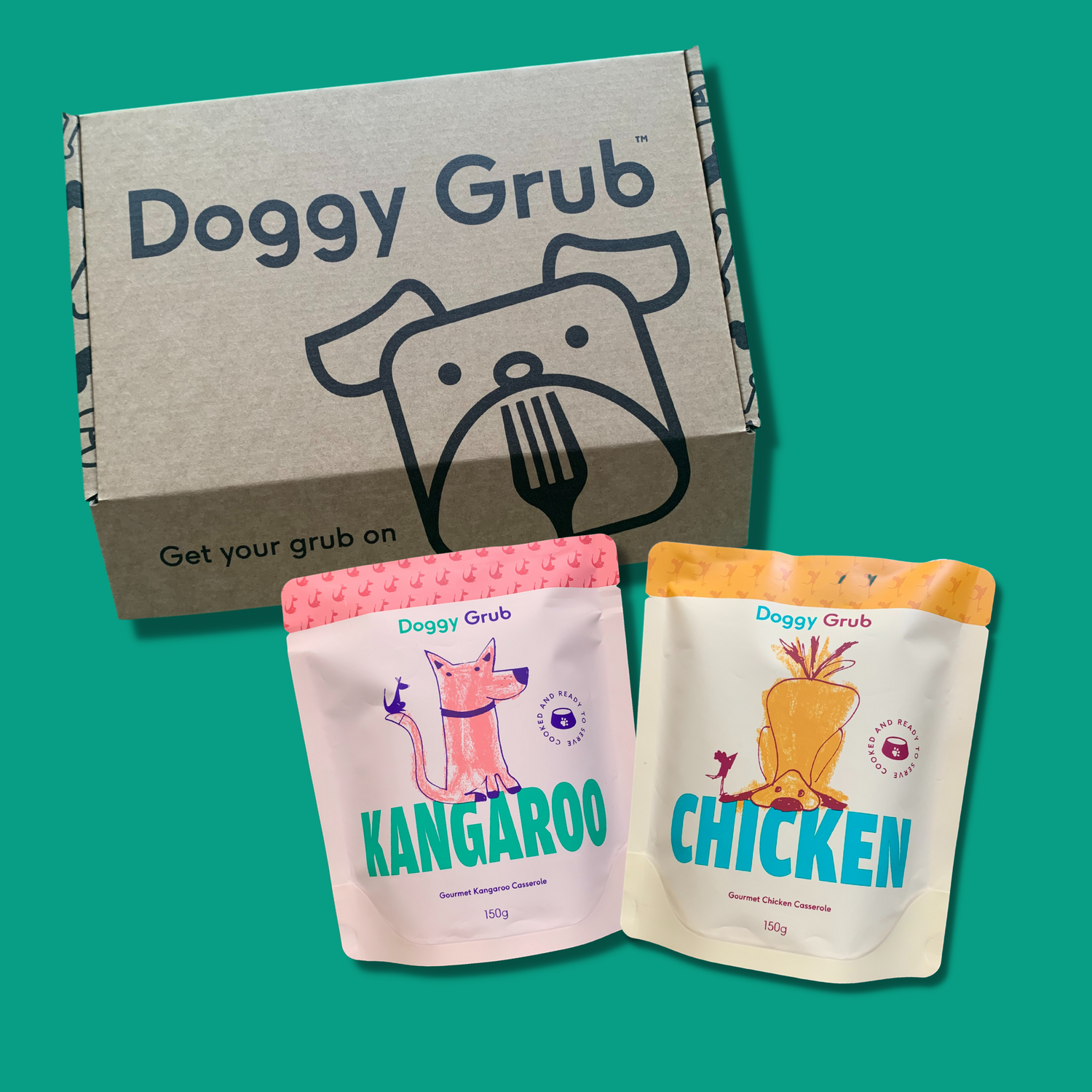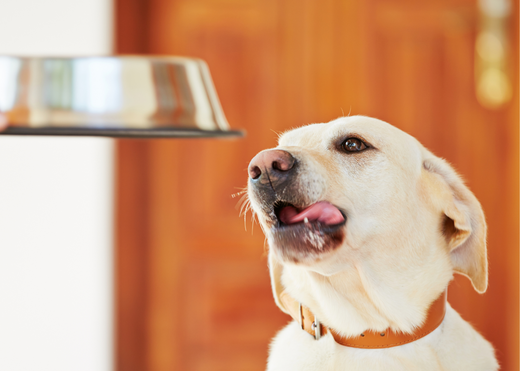Following the many recalls the pet food industry is experiencing, pet owners are ever more interested in knowing exactly what goes into their dog’s bowl.
Becoming educated on the subject of pet nutrition is a fantastic first step towards creating a healthy life for your fur friends.
But, it’s not always easy to know what to do. Should I be cooking for my dog? Where do I start? Will it be balanced enough? How much should I feed?
It can quickly become very overwhelming!
Here we’ll be giving you some pointers to help you with your first home cooked dog meals.
Home cooked diet for dogs: main ingredients.
Our suggestion if you want to prepare home-cooked meals for your pet is to start small.
Plan to feed 2-3 home cooked meals per week and keep your dry food. That way, you don’t need to fear nutritional imbalance and you’re not a slave to the kitchen.
The following ingredients should always be part of your home cooked meals, in the suggested quantities.
Note: quantities and ratio will change depending on your dog’s breed and needs. At Doggy Grub we like a ratio of 60% protein, 40% carbohydrate, veggies & healthy fats.
- High quality proteins: meat, seafood, eggs or legumes. 30-60% of your meal.
- Carbohydrates: sweet potatoes, brown rice, buckwheat, quinoa. 30-60% of your meal. By changing the protein and carbohydrate source, you provide variety of taste, flavour and consistency without changing the nutrient profile.
- Fibers: vegetables and fruits (carrots, broccoli, green beans, zucchinis, berries, apples, bananas). A source of fiber in the diet is desirable for intestinal health. 10-30% of your meal.
- Fats: Coconut, olive, hemp or flax oil. You can also add ground flaxseeds or linseeds or nut butters (peanut, almond etc). ½-3 tsp depending on your dog’s size.

Should I add a supplement to my dog’s home-cooked meals?
To supplement or not to supplement? The $1M question!
Supplements help complete the nutritional balance of your home-cooked meals by adding macro- and micro-minerals, vitamins and in some cases, amino acids.
Adding supplements to homemade diets for dogs can be difficult and you need to obtain a supplement designed specifically for canine homemade diets.
At Doggy Grub, we believe a varied diet will provide your dog with all the nutrients they need. Mother nature has created ingredients with wonderful health profiles, that is why we recommend using a natural form of supplementation rather than synthetic.
Doggy Grub Grinkles Topper The OG is a superblend using superfoods such as spirulina, wheatgrass and dulce flakes that will provide your dog with important micro-nutrients such as iodine and contain several nutrients, including B vitamins, beta-carotene, and vitamin E.
You can include these types of superfoods on rotation, atop your dog’s home-cooked meals.
Continuing to feed kibbles will also alleviate the fear of not feeding a diet that is balanced enough.
Your pet should be examined by a vet at least yearly. This will allow you to rest assure your dog is not lacking any important nutrients and is doing well.
The best overall indication of nutritional health is your pet’s body weight, activity level, normal skin and eyes, more specifically, the lens and retina. Your veterinarian may perform a few routine exams as part of the general evaluation.
Cooked or raw dog food?
We suggest cooking your proteins and carbohydrates for digestibility and food safety. However, if your dog is used to being fed raw, then you can keep feeding that way.
Vegetables and fruits can be given raw; though we recommend grating or dicing in small pieces for better digestibility. Steamed and pureed veggies will also lock in the nutrients and improve absorbability once in the digestive track.
Legumes such as lentils or beans should be well-washed and mashed.
How to store my dog’s home-cooked meals?
Homemade diets generally lack preservatives and antioxidants so the food must be stored in small quantities in the fridge or the freezer. They also contain much more moisture making it highly susceptible to bacterial, fungal or mould growth when left at room temperatures.
Think about it the same way you would your own food: once cooked, don’t keep it for longer than 2-3 days in the fridge.
The best way to do this is to cook a big batch then portion out your dog’s meals in zip bags with the date written on them. Keep 2-3 in the fridge and freeze the rest.
How much food should I feed my dog?
Many pet parents struggle with an important aspect of dog nutrition: proper portioning.
We assume that big dogs need a big amount of food. But growing pups will also have different needs.
A common practice is to feed dogs according to their weight. As such, dogs are categorized by breed size: toy, small, medium, or large.
Other factors such as activity levels, age (puppy or senior) and whether your dog has been neutered or not will determine portion sizes.
There is always a bit of wiggle room if your dog falls in between two sizes. Follow the recommendations for your breed based on the ideal weight your dog should be at, but make sure to also monitor your dog’s behaviour.
Is your dog continuously leaving food in the bowl? Is she putting on weight rather than staying stable? Is your pet asking for more and still seems hungry after dinner? These are all signs that your need to adjust your portions. Luckily, with a bit of tweaking, it won’t take you long to find out what the perfect portion is. Us humans, tend to show our love through food, but remember, treats should never make up more than 10% of your dog’s diet.
At Doggy Grub, we use your dog’s breed, age, weight, and activity level to determine how much they should be fed, then portion out your dog's meals.
Now that you know the basics, grab your apron and start experimenting with this new home cooked dog food recipe!
Disclaimer: Before making any changes to your dog’s diet, we recommend that you use your judgment and make decisions with your vet nutritionist or a vet with extensive knowledge on pet nutrition. Make sure to introduce any new food slowly to prevent upset tummies.
Want to be the first to get your paws onto the hottest topics? Subscribe to our newsletter!
-------------------------------------------------------------------------------------------------
The Doggy Grub blog is dedicated to helping dogs and their owners achieve happier, healthier lives, changing the way we feed our dogs one bowl at a time! If you would like to know more about our fresh food head to Doggy Grub











4 Comments
I have recently adopted two Shihtzu/ poodle mixture 6 yr old dogs 1 is 10kg and the other 51/2 kg. How often should they be fed and what amount. I make their food using meat &vegetables.
Served with a small amount of biscuits.
@KarlaMendez That’s a great idea! This should make his kibble much more interesting and palatable. We also have a few articles on fussy eaters and tips and tricks you can do to entice your dog to eat. I hope they can help :) Keep up the good work!
@Josephine Carr
I’m literally here for the same reason, I have a very small dog maltese/shih tzu that I rescued and he doesn’t like kibble and will refuse to eat and will eat every couple of days when he absolutely is starving but I can’t deal. I’ve decided to cook and store in cube sized portions and add to his kibble to entice him.
My Shih tzu has become a very fussy eater..I’m at my wits end what to do